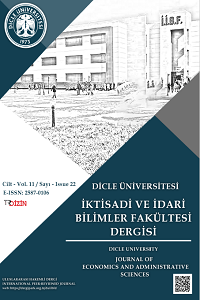Research Article
Issue Editorial Board













Doç. Dr. Dicle Üniversitesi İktisadi ve idari Bilimler Fakültesi Sosyal Hizmet Bölümü



Aim & Scope
The aim of our journal is to contribute to scientific knowledge by giving place to original and scientific studies in the fields of economics and administrative sciences and political sciences, which are sub-branches of social sciences.
Our journal accepts articles written in Turkish and English languages from the disciplines such as Political Science and Public Administration, Economics, Business Administration, Finance, International Relations, Labor Economics and Industrial Relations, Healthcare Management, Tourism Management, International Trade and Logistics, Econometrics and Social Services.
Author Guidelines
AUTHOR GUIDELINES
According to the global rules of scientific texts, all articles should contain general elements completely such as Title, Author Information, Abstract, Keywords, Section Titles, Citation, Result and Bibliography. These are organized as below.
The articles send to Journal of Faculty of Economics and Administrative Sciences should have the title in English, Abstract and Keywords.
Also, JEL codes are stated about the subject of the articles under the abstracts both in Turkish and English.
Page Setup and Print Format
The articles should be in size of A4 (29.7x21 cm), all the margins should be set as 2.5 cm, written with MS Word with Times New Roman font, 12 points size and 1.5 line spacing.
The pages should be numbered. The texts should not exceed 10.000 words including abstract and bibliography. The emphasised sections in the texts should be italic, not bold. Quation mark, italic letters should not be used as they are double emphasis.
Title
The title should be consistent with the article, directly related with the content stating it corporally with a modest length.
The title should be on the top of the texts, centered, written with capital letters, 12 points, bold and single spacing.
The title in English should be written after the abstract and keywords in Turkish and above the abstract in English.
Author Information
Author(s) name(s) should be 6 nk under of the title without without entitles, right aligned, normal and last name(s) are in capital letters. Author(s)’s professional information, their entitles, institution, e-mail and ORCID numbersshould be separated with comma and full stop at the end, there should also be a star mark (*) on the right side of the author names and it should be shown as normally written footnote at the end of the page with 10 points size.
Example:
Mehmet Emin KURT*
* Dr. Lecturer, Dicle University Faculty of Economics and Administrative Sciences, Department of Health Management, memin.kurt@dicle.edu.tr, ORCID: 0000-0002-7181-8681.
Abstract
Abstract should be under the title, aligned to the right, with bold, italic and 12 points size (Abstract) and it is a summary in Turkish that states the content properly with 10 points size and between 100 words at least and 200 words at most.
The abstract should not contain citation, figure or table numbers.
The abstract in English should be under Abstract and keywords in Turkish, one line below of the title in English, under the (Abstract) title which is written bold and italic in 12 point whereas the content is written with 10 points size and normally.
JEL Codes
Related JEL Codes should be added under keywords in Turkish and English. The abstract without will not be evalulated scientifically.
Keywords
Keywords should be consistent with the contect of the article and should involve all of it.
It should be under abstract with 12 points size, under abstract with 6 nk space, plain and bold (Anahtar Kelimeler:), on the right side of the title, with 12 points size again but italic and there should be 5 keywords at most.
The abstract in English should be after the abstract in English with 12 points size, under abstract with 6 nk space, plain and bold (Keywords:), on the right side of the title, with 12 points size again but italic and there should be 5 keywords at most.
Main Text
The size of the main text should be 12 points with 1.5 line spacing and should be with justified alignment. There should not be any spacing at the right sight of the starting of the paragraphs. The spacing between paragraphs should be 6 nk.
Section Titles
All section titles are in capital letters and bold and numbered as 1., 2., 3.,. All subtitles are bold, first letters are in capital and numbered as 1.1, 1.2., 1.1.1.,.
If there are (INTRODUCTION), (RESULTS) and (BIBLIOGRAPHY) parts, these titles are not numbered.
Tables and Figures
Tables should be aligned to the left in the text and the content should be written in 10 points size.
Tables are numbered before titles (Table 1.), bold and 10 points size. The number and titles of tables should be written with 10 points, regular and plain, first letter of each words are in capital. If tables are citated, the sources should be shown below the table with 10 points size and at the right side of (Source: ) title.
The left edge of the table should be integrated with the edge of the test.
An example of table title:
Table 1. Distribution Of The Export According To The Countries (September - December, million $)
Figures and graphics are written as (Figure 1.) and (Graph 1.), bold, written in 10 points size and numbered as that, they are also titled with 10 point size, bold, plain and first letter of each word is written in capital.
Pictures
Pictures, photos and all other visuals are given just below of the section or paragraph it is given in the text as colored, high resolution or scanned.
Pictures are also numbered and titled as tables and figures (Picture/Visual/Photo 1.)
The sources of the pictures are cited under pictures as tables and figures.
Citations and References (Attributions)
The citations taken from different sources should be written in the text as in the paranthesis, name(s), surname(s), publishing date and the page of the citation as below:
Example: (Koçal, 2018:390)
The citation from sources with two arthors should be written in the text with only last names of the authors seperated with “and” conjunction:
Example: (Aslan and Koçal,2016:1)
If there are more than two arthors, only first writer’s last name and “and oth.” should be written:
Example: (Aslan and oth. 2018: 18).
Direct citations should be given in quotations.
Citations and References
Direct citations should be given in quotation marks. The direct citations less than 2.5 lines should be written in the line, citations longer than 2.5 lınes should be 1.5 cm inside from the right side of the line as block and 11 points size.
You should avoid using footnotes as much as possible, it should only be used for explanations and additional information references and automatic numbering should be used for footnotes.
If name of the cited writer is given in the line, only the publishing date of the source and page number of citation should be given.
Example: “According to Koçal (2014: 162), küresel kapitalizmle ilişkili bir ülkede siyasal iktidara gelmek, küresel hegemonyanın desteğini gerektiriyordu.”
If the citation is taken from a secondy source, the main source should also be indicated:
Örnek: (from Çemberlitaş 2018: 36, Demirhan 2016: 25).
The citations from periodical publications such as newspapers, journals, they sould be given with the last name if available and publication date. If the last name is not available, publication name and the date should be given.
Example:
Direct citations from internet should be given in paranthesis with only the name of the web page.
Example: (isepa.org).
If publication date is not available, last name of the writer or the name of the source should be given such as encyclopedia.
Bibliography
All the citations, table, figure, picture sources should be given at the end of the text under the title of (BIBLIOGRAPHY).
The sources should be listed alphabetically according to the last name of the writer.
The sources should be listed with single spacing and 6 nk space.
Sources should be given as last name of the author, name, publishing date in the paranthesis, publication title, publication location and Publisher
If there are two authors, last name of the first author is written first, there is no need to consider last name of the other authors when listing the sources alphabetically.
Example
Demirhan, Y. and S. Aslan (2015), “Türkiye’nin Sınır Ötesi Göç Politikaları ve Yönetimi”, Birey ve Toplum, 5(9), s.23-62.
Book
Books should be references as author(s), publishing date in paranthesis, book name is italic, publication location and publisher, all should be seperated with comma and finished with a full stop.
Example
Demirhan, Y. and S. Aslan (Ed.) (2016), Türk Siyasal Hayatında AK Parti Dönemi, Ankara: Orion Kitabevi.
If the book is a compilation, translation and prepared for printing, translator or editor names should be given after the author and text information.
Example:
Koçal, A. V. (2014), “AK Parti’nin Siyasal Sosyolojisi: Türkiye’de Muhafazakâr Dönüşümün Toplumsal Temelleri”, (Ed.) Nafiz Tok, Mehmet Özel, Ahmet Vedat Koçal, Yeni-Sağ, Küreselleşme ve Türkiye, Türkiye’nin AK Parti’li Yılları, (s. 19-128), Ankara: Orion Kitabevi.
Example:
Weber, M. (2006), Sosyoloji Yazıları, (Çeviri: Taha Parla), İstanbul: İletişim Yayınları.
Book Chapter
Title of the book chapters should be given in quotation marks, name of cited publication, authors or editors or compilers, name of the publication is italic, page number is in the paranthesis with publication location information.
Example
Aslan, S. (2013), “Tek Parti Döneminin Siyasal Analizi”, (Der.) Ahmet Karadağ, Osmanlı’dan Günümüze Türkiye’de Siyasal Hayat, (s.35-98), Ankara: Orion Kitabevi.
Article From Journal
The articles published in periodical academic journal are given as authors, publication date in the paranthesis, article title is in quation marks and plain, journal name is italic, volume number is plain, number of the journal in paranthesis and the pages of the article are given as page interval and in the paranthesis.
Example:
Erkuş, H. and İ. Çemberlitaş (2016), “İslâmî Finans Araçlardan Olan Sukuk’ların Muhasebeleştirilmesi”, Journal of Faculty of Economics and Administrative Sciences, 6 (11), s.245-262.
If more than one articles from the same authors will be shown in bibliography, after the first articles is given, it is not necessary to repeat name and last name order fort he other articles of the same author, a long line is put instead of name and last name information. The listing is made according to the title of the articles as it is not possible to list them according to the last name of the authors.
Example:
Eser, H. B. and Ö. Taylan (2016), “Doğrudan ve Temsili Demokrasi Modelleri Üzerine Bir Eleştiri Denemesi”, Muhafazakâr Düşünce, (48), s.283-298.
_______ (2017), “Antogonizmadan-Agonizmaya: Radikal Demokrasi”, Muhafazakâr Düşünce, (50), s.121-126.
If there is more than one article of the author in the same year, (a, b, c,…) is added next to the publishing date of the article with the alphabetic order.
Example:
Kayacı, M. (2017a), “Tartışmalı Düşünür Machiavelli Hakkında Kısa Bir Değerlendirme”, Dicle Üniversitesi İktisadi ve İdari Bilimler Fakültesi Dergisi, Uluslar arası Ekonomi, Siyaset ve Yönetim Sempozyumu (ISEPA ’18) Özel Sayısı, s.221-235.
_______ (2017b), “Türkiye’de Sağ Seçmen Bloğunun Konsolidasyonu Bağlamında 16 Nisan Referandumu”, Strategic Public Management Journal, (3), s.151-160.
Thesis are given in the bibliography as last name and the name of the author, the completing date of the thesis in the paranthesis, full title of the thesis as italic, type of the thesis and publication status, the city of the university in which the thesis is prepared and the name of the university.
Example
Altındağ, Ö. (2017), Diyarbakır'da Yaşlı Olmak: İhtiyaçlar, Sorunlar ve Hizmet Beklentileri, Yayınlanmamış Doktora Tezi, Ankara: Hacettepe Üniversitesi.
If there are sources obtained from the internet, last name and the first name of the author, title of the source in quotation marks, internet address as underlined, the date of access in paranthesis (Access Date: ) in the end.
Example:
Demirhan, Y. (2017), “Türkiye’de Hükümet Sistemi Arayışlarına Halkın Bakışı: Diyarbakır Örneği”, https://www.yorsam.org/turkiyede-hukumet-sistemi-arayislarina-halkin-bakisi-diyarbakir-ornegi/, (Access Date: 27.11.2018).
The citations from encyclopedia articles, if it is known, firstly the last name and the name of the author is given and followed by publication date of the article, the full title of the article in the quotation marks, the full name of the encyclopedia as italic, volume number, publishing location, publisher and page interval.
Example
Kılıçbay, M. A. (1985), “Osmanlı Batılılaşması” Tanzimat’tan Cumhuriyet’e Türkiye Ansiklopedisi, 1. Cilt, İstanbul: İletişim Yayınları, s. 147-152.
The citations from archive sources are shown as below in bibliography:
Başbakanlık Osmanlı Arşivi (BOA), Tapu Tahrîr Defterleri (TT.d.), 251.
The citations from library sources (Hand Manuscripts etc…) are shown in the bibliography as Author, name of the publication, library, collection, catalogue number and the page.
Example:
Ebû İshakzâde, Mehmed Es‘ad b. İsmâil el-İstanbûlî, Hülâsâtü’t-Tebyîn fî Tefsîri Sûreti Yâsîn, Süleymaniye Ktp., Hâlet Efendi, nr. 23.
Ethical Principles and Publication Policy
Dicle University Journal of Economics and Administrative Sciences has adopted the International Standards of the Committee on Publication Ethics (COPE) for Editors and Authors in their manuscripts.
The submitted studies are examined with plagiarism programs.
Journal does not have any article submission and processing charges.
PUBLICATION ETHICS FOR AUTHORS
1) For the submitted scientific manuscripts, all responsibilities caused by non-compliance with ethical rules belong to the author.
2) The submitted manuscripts must be original.
3) The submitted manuscripts should not have been sent to be published elsewhere at the same time.
4) The published manuscripts should not be resubmitted to publish in our journal.
5) After submission, new authors cannot be added or removed to the manuscripts.
6) In terms of ethical rules; the situations requiring Ethics Committee Permission for the researches to be evaluated in the journal are as follows:
- Any research carried out with qualitative or quantitative approaches that require data collection from participants using survey, interview, focus group work, observation, experiment, interview techniques,
- Use of humans and animals (including material/data) for experimental or other scientific purposes,
- Clinical researches on humans,
- Researches on animals,
- Retrospective studies in accordance with the law of protection of personal data.
PUBLICATION ETHICS FOR REFEREES
1) After the submitted works are evaluated by the editor, they are sent to two referees according to the blind referee system. In the case of one acceptance and one rejection, a third referee opinion will be received.
2) Manuscripts are evaluated by referees who are confidential, independent, and expert.
3) The manuscripts can be published with a positive opinion of at least two referees.
4) Neutral and fair referees will be determined for the evaluation of the manuscripts.
PUBLICATION ETHICS FOR EDITORS
1) The editor has the right to accept or reject the original manuscripts to evaluate according to the scientific field of the journal.
2) The editor will provide to send manuscripts to referees who are experts in their field.
3) A fair and fast evaluation process is provided by the editor.
4) The editor has the right to make the final decision of the publication of manuscripts, based on the opinion of the referees.
PUBLISHING POLICY
The journal will be published twice in a year.
Journal does not have any article submission and processing charges.
Dicle University Journal of Economics and Administrative Sciences accepts articles written in Turkish and English languages from the disciplines such as Political Science and Public Administration, Economics, Business Administration, Finance, International Relations, Labor Economics and Industrial Relations, Healthcare Management, Tourism Management, International Trade and Logistics, Econometrics and Social Services.
Submission of a manuscript implies that the work submitted has not been published before and/ or it is not under consideration for publication anywhere else. Also, the article should be prepared in accordance with the “instructions for authors”. While the official languages of the journal are Turkish and English, all manuscripts have to include an abstract written in English. These instructions provide the referees fast and correct evaluation and publication process. After the manuscript is evaluated by the editor, it will be sent to two referees who are experts in their area. These referees will remain confidential and thus independent. Manuscripts can be published with the positive opinion of at least two referees. The evaluation process will be completed at the soonest time possible.
Price Policy
Dergimiz yazarlardan hiçbir aşamada ücret talep etmemektedir.
All works published in this journal are licensed under the Creative Commons Attribution-NonCommercial 4.0 International (CC BY-NC 4.0) License.


